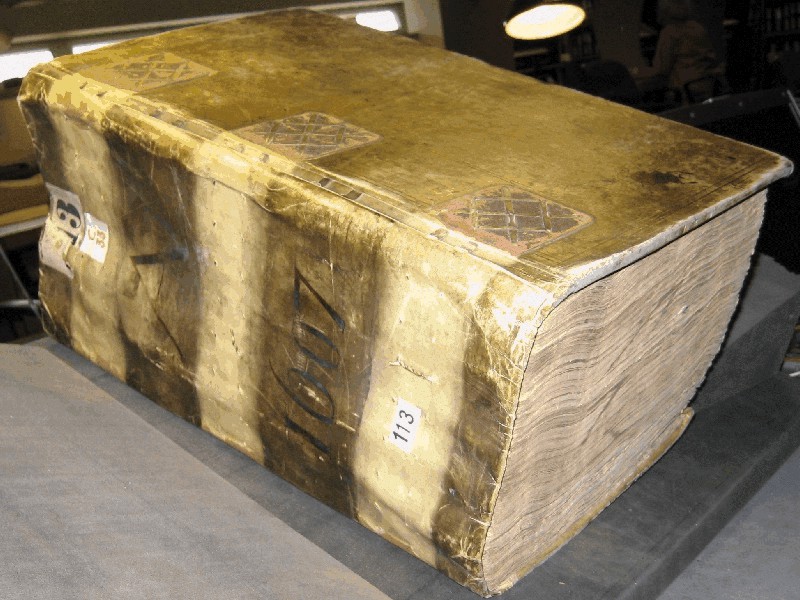


| Because the plea rolls were digitized while still bound, the front and the back of the individual membrane are disconnected and in different folders. That disconnect produces some academic concerns: navigating the site, citation form, and website stability. |
| Finding a particular membrane cited from the original document. Navigate by using the thumbnails of the images. On the thumbnails the reader will usually but not always be able to identify markers that indicate every tenth membrane (usually but not always a black foam bar placed horizontally on the membrane or a blue or purple paper rectangle) and every fiftieth membrane (usually but not always a rectangular document weight or a red paper rectangle). Those markers are the best way to reach an approximate location for a particular membrane being sought. Since each membrane requires one to five images, simply counting the number of images is less reliable. The markers for tenth and fiftieth membranes are more vital for the dorses, because the dorse membranes do not have page numbers at the bottom of the membrane. When trying to locate a membrane that has been cited from the original document, one can thus relatively rapidly locate the desired membrane within two or three membranes. Occasionally the marker was omitted from the proper location, so occasionally there are twenty membranes or 35 to 45 images between markers. |

Citing to a case found in this database.
Although there are many incorrect citation forms, there is no single correct form: requirements will vary by discipline and by country. The AALT has become a standard
site for research across disciplines and for six centuries of history, so readers will be expected to recognize the site and be able to find it. Nonetheless, an initial
note should contain the details: "Citations to National Archives documents (CP40, KB27, E368, E159, JUST 1, C33 [etc as relevant]) refer to the digital archive assembled by Robert C. Palmer, Elspeth Rosbrook, and Susanne Brand, The Anglo-American Legal Tradition available at aalt.law.uh.edu/aalt.html, hereafter AALT." U.S. legal citation form for individual notes would be "CP40/355 AALT 4180 (1348), http://aalt.law.uh.edu/E3/CP40no355/bCP40no355mm1dto100d/IMG 4180.JPG". U.K. form might well prefer something like TNA, CP40/1000, m. 101, accessed at http://aalt.law.uh.edu/AALT2/H8/CP40no1000/aCP40no1000fronts/IMG_0205.htm. The virtue of both these forms is that a paper publication transferred into digital form will allow the reader to go directly to the document cited. Experience indicates, however, that publishers may refuse the form when there are many such citations, because it makes the individual footnote with dozens of citations unbearably long. In such situations publishers have in fact resorted to something like (after the initial long form note above that cites also TNA) CP40/1000, m. 354d (AALT IMG 346). In situations in which the membrane number cannot be ascertained (as when the bottoms of the membrane have been damaged for many membranes), the membrane would be omitted and the AALT frame would be the precise reference alone. The best advice is to check the practice of the publication to which you are submitting your piece. |

| Website stability.
This website is established for stability. The O'Quinn Law Library is thus the licensee in the permission by the National Archives. Also, the website is independently funded with sufficient resources to provide for ongoing maintenance and replacement of the server in the future. The funding after the purchase of the original server was $90,000, a sum that can only be used for ongoing maintenance and server replacement. It is therefore safe to cite to images in this website. Additional funds will be transfered annually into the fund as available, to be used to accelerate acquisition of material for the site. |